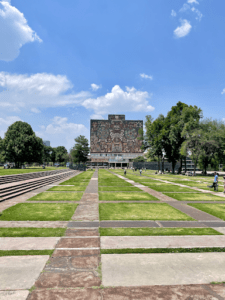Mexico’s architecture is a diverse blend of history and culture, ranging from ancient Mayan and Aztec pyramids to Spanish colonial structures and contemporary skyscrapers. This rich architectural tapestry offers much to explore for architects and enthusiasts.
One standout illustration of architectural syncretism is the National Autonomous University of Mexico (UNAM) campus in Mexico City. Finished in 1954, it stands as a pivotal achievement in modern Latin American architecture and planning. Spanning over seven square kilometers, this insti tution is home to a community of over 300,000 students, teachers, and staff.
tution is home to a community of over 300,000 students, teachers, and staff.
The UNAM campus was designed by a team of architects led by Enrique del Moral, Carlos Lazo, and Pedro Ramírez. Their goal was to reflect the identity and values of Mexico and the academic excellence of the university. The campus layout draws inspiration from elements of pre-Hispanic cities, like the main axis from the Death Road in Teotihuacan and the asymmetric balance of the Monte Alban Main Plaza.
The campus stands out for its architectural uniqueness, blending Mexican architectural tradition with the principles of International Modern Architecture. Alongside Brasilia and Chandigarh, it’s one of the few places in Latin America where modern architecture is fully expressed. The murals integrated into the architecture testify to a harmonious coexistence, following the principles of Plastic Arts Integration and the New Monumentality.
To achieve this syncretism of tradition and modernity, the builders invited renowned artists of the time, including Diego Rivera, David Alfaro Siqueiros, Juan O’Gorman, Jose ·Chavez Morado, and Francisco Eppens Helguera. These artists crafted exquisite paintings and sculptures that adorned building walls and facades, portraying Mexican history, culture, and science.
The outcome is a school that combines functionality and beauty with deep symbolism and educational value. Here, students glean knowledge not only from textbooks and lectures but also from the art and architecture that surround them. It’s a place where they can cherish their heritage and find inspiration for the future.
UNAM University was declared a UNESCO World Heritage Site in 2007 as one of the best examples of 20th-century modernism incorporating local cultural elements. It is also a testament to the creativity and diversity of Mexican architecture. Since its origin, Mexico National Autonomous University has occupied the first place among the Hispanic world universities, demonstrating recently its high-quality educational and cultural leadership by taking part in the Best One Hundred International Universities group and heading the list of Hispanic universities.
If you want to learn more about the UNAM campus or other aspects of Mexican architecture, you can visit this source: Latin American architecture – Mexican, Colonial, Baroque | Britannica
